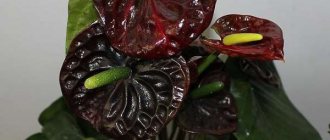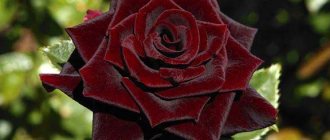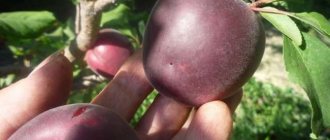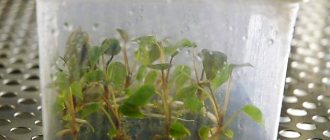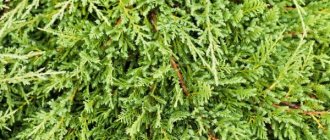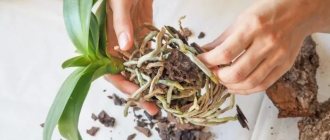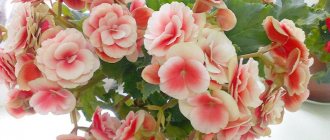What black anthurium looks like: varieties
There are many varieties of this species. Below will be a description of the most popular ones.
Black Love
It grows as a shrub that can reach a height of half a meter indoors. The leaves have a bright dark green color; the bud itself first grows in a beige hue, however, when it blooms completely, it transforms into a different color. Anthurium Black Love turns dark burgundy when it blooms. Thanks to the heart shape, the flower received the romantic name Love.
Anthurium black
Black Beauty
This variety is more difficult to find than any others. Its main difference is its shape, which is similar to a tulip. The leaves are dark green with a burgundy vein. The flower itself, just like the previous one, changes its color as it blooms from dark burgundy to black. Anthurium Black Beauty at home can grow up to 65 centimeters.
Black queen
The difference with the others is the red color of the buds and bedspread. Lovers of home plants appreciated this variety for the beauty of its green leaves, which do not lose color and brightness at any time of the year, and its deep red flowers.
Note! Anthurium Black Queen is a hybrid; therefore, flowers of different colors (red or black) can grow on one bush. Queen is translated as queen, and this is truly a royal variety.
Black Prince
Anthurium Black Prince is refined and graceful, stands out among other home flowers, creating a bright accent in the interior. The plant can grow up to 1 meter, delighting the owner with its brightness and noble appearance. Prince lives up to its name 100%.
The black prince looks exquisite
What is special about the variety?
The plant has all the characteristics of the parent varieties: the anthurium cob is yellow-green, but the spathe itself on the flowers of one bush can be either the same color or of different colors. During the budding phase, a rich cherry color predominates, but when the spathe is fully opened, it turns black with a dark red tint. However, there are anthuriums that can have flowers with both black and cherry stipules on one plant.
Black or red covers on anthurium cobs are in perfect harmony with dark leaves, which have a glossy sheen and are painted with lighter veins.
Connoisseurs of exotic plants try to get Black Queen into their collection, although some gardeners prefer to avoid it due to its almost mournful coloring.
Features of home care
In order for these varieties to please with their healthy and beautiful appearance, it is necessary to provide them with careful care.
Temperature
Anthurium (Male Happiness) flower - description and cultivation
This genus of flowers loves warmth. In the warm season, it feels good at temperatures of +20-25 degrees. In the autumn, the temperature is lowered to 12-15 degrees, thus the flowers are gradually transferred to wintering.
Important! It is necessary to ensure that cold air does not reach the bushes and that there are no drafts around.
Lighting
Anthurium should not be kept in direct sunlight. To make him feel comfortable, he is placed on the window sills on the western or eastern side of the home. If this is not possible, then you can darken the window or move the flower during the day.
Watering
Adult plants are watered abundantly as the top part of the soil dries out; a young flower is watered more often. The average amount is 2-3 times a week. Water should be done without touching the plant with water (water on the buds can form brown spots), using warm, clean water.
Important! The remaining water from the tray must be poured out immediately.
Humidity
These plants love humidity, especially during hot weather. At this time, they should be sprayed and given a warm shower. You can also place a vessel with water nearby to increase air humidity.
In addition to the above methods, to provide moisture for plants, they resort to covering the stems with moss, which are sprayed periodically. In addition, you can place flowerpots with bushes on a tray with wet gravel and expanded clay.
Priming
Ready-made primer compositions are available for sale.
Ready-made soil from the store has the optimal composition
But you can prepare the soil yourself; for this you need to mix the following ingredients:
- charcoal;
- coarse sand;
- pine bark (medium sized pieces);
- sphagnum moss;
- humus;
- leaf soil.
Take 1 part of each component. You also need to add drainage.
Feeding
The plant must be fertilized from March to September so that it pleases with its beautiful and healthy appearance. During this period, feed the plant once a week.
It is preferable to choose ready-made fertilizers:
- "Forte" includes magnesium and succinic acid.
- "Bona Forte" No. 1 or No. 2. It is a complex of mineral and organic fertilizers.
They are used for watering and spraying according to the instructions on the package.
You can also prepare the solution at home yourself. To do this, use one of the following recipes:
- a teaspoon of sodium sulfate per 2-3 liters of water;
- a teaspoon of “Agroschool for flowering plants” per 2 liters of water;
- 0.5 liters of fermented mullein per 10 liters of water.
It is worth watering with different fertilizers in turn.
Note! Sick flowers are not fed. After transplantation, give them additional feeding after 2 weeks.
Air temperature and humidity
The optimal air temperature for anthurium depends on the vegetative phase. During the period of active growth and flowering, the air temperature in the room should be within +20+25°C. The evergreen subshrub enters a dormant phase after a long flowering period, often lasting 10-12 weeks.
During the resting phase, the air temperature in the room with anthurium should not drop below +15+18°C. In a cooler room the plant will die.
The epiphyte requires high air humidity and responds positively to year-round daily spraying with soft boiled water in the morning.
When and how does it bloom
Anthurium - propagation at home
If the plant is well cared for, it can bloom regularly, usually from March to November. By winter it goes into hibernation.
The flowering of the innerium looks unusual
The bud can grow from the center of the shoot, from the side. At first it looks like an arrow, different in color from the leaves. The flower will take a long time to grow. The next stage is opening: the pistil is shown, and after a few days the bud opens completely.
Interesting! The flower remains in its original form for up to 2 months; after this period, the shade will become paler and it will dry out.
Similar flowers
- Calla Black Crusader . The shiny blanket is somewhat curled and has a blackish tint.
- Calla Black Forest . The blanket is a sail of deep purple color. There is a white border along the very edge.
- Calla Black Pearl . The bedspread has an open coverlet in a deep purple hue.
- Calla Black Star . The bedspread has the shape of a tulip, the color is purple and black.
- Calla Maron Sensation has a shiny cover the color of ripe cherry with a blackish tint.
Despite the “royal title”, the Black Prince anthurium is quite unpretentious and hardy. With proper care, it grows quickly and easily reproduces at home.
If you find an error, please select a piece of text and press Ctrl+Enter.
Trimming
Pruning should be done in early spring, thereby rejuvenating adult plants. Lateral and apical stems can be used for propagation.
Anthurium flower: leaves turn yellow - what to do
Trimming steps:
- Remove dead lower leaves.
- Trim off faded buds.
- Separate the side stems with part of the root system. This must be done especially carefully.
- Cut off the tops of the stems.
When replanting a plant, you also get rid of rotten and dry roots.
Important! Do not damage the central trunk when pruning.
What do spots on anthurium leaves mean?
Dark green leaves serve as a kind of health indicator for the flower. At the first signs of a change in their color, you should immediately take measures to save the anthurium:
- yellowing of leaves - lack of light, improper watering or lack of nutrients;
- light or brown spots - from the cold;
- black spots – excess calcium in the soil.
Stains on the bedspread indicate that droplets of water got on them during spraying.
Video about the features of caring for Black Queen anthurium
How does black anthurium reproduce?
Propagation by cuttings and side stems is possible.
Cuttings
This method is simpler and includes the following steps:
- Side shoots with roots are separated.
- These shoots are transplanted into a separate container.
- The apical stems with 2-3 internodes are cut off for cuttings.
- In a wide container, the cuttings are deepened by 1 centimeter.
- The greenhouse is covered with film;
After a month, the bushes can be transplanted into pots.
Seeds
Propagation by seeds is more difficult. In addition, hybrid plants do not transfer their characteristics to the seeds.
Transplanting seeds includes the following steps:
- The seeds are soaked in a manganese solution. Germination can be carried out on damp foam rubber.
- Afterwards, the seeds are distributed on the surface of a moist substrate in greenhouse conditions.
- After a month, they are transferred to containers with water for germination.
Description and features
Under natural conditions, ficuses, without any obstacles, grow up to 40 meters in height, and in appearance they bear little resemblance to the indoor specimens that flower growers are accustomed to.
Powerful aerial roots form the tree trunk and support its high branching crown. In the room, ficus trees also begin to branch if there are suitable conditions for this, but small-sized apartments are not conducive to this.
The height of the Black Prince will depend on the size of the pot in which it is grown and the height of the ceilings in the room. The root system of the flower is very powerful and branched.
And aerial roots also grow, designed to collect moisture from the atmosphere and maintain the crown. If a leaf or petiole is cut, a white milky sap will appear.
Carefully! When propagating by cuttings, wear gloves, as ficus sap can cause allergies and sometimes severe skin irritation.
The distinctive features of the Black Prince are its large leaves of a dark green color, which in certain lighting look almost black, for which it received its name. In the morning and evening, in diffused light, the plant looks dark; in bright sunlight, the color becomes lighter. The upper leaf, while young, is reddish in color. The length of the leaves is from 15 to 25 cm, and their width is up to 20 cm; in the center of each leaf there is a burgundy vein, as in the photo.
Transfer
Young plants should be replanted once a year. Adults replant when the roots have filled the pot, about once every 2-3 years. Transplantation work is carried out in the spring, using the transshipment method.
Replanting is required when the pot becomes too small for the plant.
Stages:
- The pot is placed on its side
- Carefully remove the plant with a lump of earth
- Rotten roots are removed
- The cut areas are sprinkled with crushed coal.
- The root is carefully placed in a new pot, the roots are placed evenly.
- The remaining space is filled with soil.
- The soil on top is slightly compacted.
- Moss is placed next to the leaves.
Important! After transplantation, the plant is watered as usual.
How to achieve flowering
Even under ideal growing conditions, anthuriums produce an average of 4 to 6 flowers per year. Mature plants bloom more often and produce larger flowers than young ones. For flowering to occur, favorable conditions must be created.
- The flower requires rich, well-drained soil.
- Too little light can reduce or stop flowering.
- During the growing season, watering is done weekly.
- If the leaves lose their shine, it means that the humidity level in the room is very low. The plant is sprayed with water several times a week.
- Fertilizer with a high phosphorus content is applied monthly.
- Every 2 years, the anthurium is replanted.
- Accumulated salts after fertilizing are washed out of the soil by good watering with distilled water.
You should always remember that anthuriums are toxic, so you should keep the plants out of the reach of children and pets. Be sure to wear gloves when working with flowers and wash your hands when finished.
Sources:
https://dacha.expert/domashnie-rasteniya/tsvetushhie/anturium/vidy-ant/chernyj-prints.html https://glav-dacha.ru/anturium-blek-kvin-budni-chernogo-princa/ https:/ /stroy-podskazka.ru/anturium/s-chernymi-cvetami/
Diseases and pests
From an excess of water, insufficient lighting, and drafts, the stems can become rotten, and the leaves become covered with mold. To save the flower, pruning is carried out and the plant is transplanted into new soil.
Spraying with fungicides will help prevent yellow spots on the leaves. They also regulate watering and lighting, and remove the flower away from others until complete recovery.
Attention! If orange aphids are detected, it is necessary to treat the bush with tobacco infusion.
For the purpose of prevention, once a season you can use phytosporin-1, which can drive out pests and protect the plant from infections.
Anthurium black is a beautiful and noble flower that will delight you with its blooms all year round. But to get a flowering plant you will have to try. Care is of great importance for the health of the plant. It will require a lot of effort, but if you do everything correctly, anthurium can decorate any home.
What does Their Highness the Black Prince like?
Like all anthuriums, Black Queen needs careful care, in which the bush will not only grow well, but also bloom abundantly. To do this, you need to provide him with:
- Diffused lighting . The southern room is suitable for the plant only in winter, and it is advisable to place the pot not on the windowsill itself, but on a stand or cabinet by the window. The rest of the year, anthurium should live in the east or west; direct sunlight is harmful to it.
- Watering and spraying . In winter, it is enough to water the anthurium once a week, with the arrival of spring - double the frequency, not allowing the water to stagnate in the pot and tray. Anthurium loves showering and spraying, but only on the leaves, without affecting the inflorescences. You can wipe the leaves with a damp sponge.
- Comfortable temperature . Do not allow the temperature to rise above 25 degrees in summer, and do not allow it to drop below 12 degrees in winter.
- Periodic feeding . It is especially important to fertilize the Black Prince with complex preparations during the formation of inflorescences.
Every two years, the anthurium needs to be transplanted into new nutritious soil, but the pot should not be too large. Of course, the flower will grow in it, growing roots and foliage, but flowering will not occur until the root system fills the entire flowerpot.
The most common mistakes in agricultural technology
Inexperienced flower growers who take the risk of acquiring anthurium for the first time make standard agricultural mistakes due to excessive enthusiasm.
The most common causes of death of tropical subshrubs are:
- Waterlogging or drying out of the substrate;
- Insufficient aeration of the soil mixture;
- Keep in bright light and direct sunlight;
- Destructive drafts causing hypothermia and loss of moisture;
- An attempt to root cuttings in water;
- Hypothermia of the plant in winter;
- Sharp fluctuations in average daily temperature.
Anthurium is mistakenly considered a capricious houseplant. In fact, the main reason for the death of valuable specimens is a simple misunderstanding of the growing season of epiphytic species.
Black Queen
This variety is also often called black prince. It is usually classified as a tall variety. Another name for this anthurium is often found - “black queen”. Adult specimens reach a height of up to 80 cm. At the beginning of flowering, the erect cob turns light beige or white.
The size of the bedspread ranges from 12 to 15 cm. This will depend on the age of the flower, as well as the conditions of its cultivation. The bract is glossy, heart-shaped, with pronounced raised veins, which emphasize the unusual variety of this hybrid.
During the initial flowering phase, the cover is dark burgundy or cherry in color. Over time, this bract becomes darker, becoming almost black, but at the same time has a reddish tint.
Anthurium lighting and watering
Under natural conditions, anthuriums do not encounter direct sunlight, as they grow in the shade of tall trees.
When growing tropical crops at home, you should give preference to the windowsill of a south-east or south-west window. In winter, daylight hours are extended through artificial lighting with fluorescent lamps. The daylight hours of an evergreen subshrub are at least eight to ten hours.
Epiphytic plants absorb moisture throughout their entire being, not just their root system. Anthuriums do not have the ability to accumulate and retain moisture. The watering schedule is adjusted depending on the season, climatic conditions, and the vegetative phase of the indoor flower.
It is important to monitor the moisture level of the earthen ball to prevent drying out or waterlogging.
The epiphyte should not be watered until the top layer of the substrate dries.
Anthurium is watered at least once or twice a week during the period of active growth. Twice a month, fertilize flowering indoor plants.
The concentration of the nutrient solution should be slightly lower than that recommended on the package.
Watering the epiphyte is reduced to once every seven to ten days after flowering is completed, when the plant enters the dormant phase. The use of fertilizers during this period is completely excluded so as not to provoke the appearance of unplanned shoots.
A properly conducted resting phase is a prerequisite for abundant flowering.
Benefits and harms
The benefit of the plant lies in its ability to purify indoor air from various harmful impurities. Since furniture, linoleum, carpets and other interior items are made from synthetic materials, the need to have atmosphere-cleaning flowers in the house becomes obvious.
However, ficus can cause harm to people who are prone to allergies. It releases substances into the air that cause allergic reactions.
Therefore, if you have a ficus in the house, and someone in the family starts sneezing, itching, runny nose, and difficulty breathing, then an allergy to the plant is quite possible.
How to propagate ficus
This video shows how to propagate ficus rubber from shoots.
Ficus is propagated in the spring, when the plant begins to awaken and actively grow. For propagation by cuttings, a part about 20 cm long is cut off. The cutting should have 2-3 healthy leaves and a growth point (apical leaf).
Then you need to remove the milky juice from the cut and sprinkle it with root growth stimulator powder. The ficus is rooted in a moist substrate, the temperature should be about 23 degrees.
Another method of propagation is air layering. The root system is formed in moist sphagnum when the cutting is not yet separated from the stem. Make a cut in the area of the plant where roots will later form.
Insert a piece of wood or glass into the cut. Take sphagnum and wrap it around the trunk, and on top with polyethylene. When the roots begin to grow, separate the shoot and replant it in a pot.
Advice! The period during which the root system is formed is 1 month. However, 6 weeks must pass from the day the cuttings were planted to take root, and only after that can it be transplanted to a permanent place in the pot.
This video shows how to plant germinated ficus cuttings in cups.
Appearance from photo
The result of crossing different species has endowed this variety with the ability to produce black and red flowers on one bush. Before the cob acquires a light green color, it has a shade of beige or white.
The bush is tall, can grow up to 70 - 80 cm . The flowers are heart-shaped and reach 12-15 cm in length. A large blanket of black color with a burgundy-scarlet tint.
The leaves are slightly elongated, shaped like a dark green heart. The length of the sheet is 30 cm, and the width is 20-25 cm.
Below you will see what this flower looks like.
Reproduction
There are several ways to propagate anthurium:
- dividing the bush;
- aerial roots;
- seeds;
- cuttings.
The young plant must be separated until it reaches maturity, since its root system is constantly expanding. Every two years the grower has the opportunity to divide the flower. To do this, you just need to free the root system from the soil, then carefully stretch it into two parts and plant it in separate containers. It must be remembered that the planted part will not bloom profusely in the first year.
As the anthurium grows, the roots come to the surface. They can simply be covered with soil, or they can be cut off and planted to form a new bush. The instrument must be disinfected; the cut is treated with an activated carbon solution to prevent infection with fungal or bacterial infections.
Anthuriums grow easily from cuttings. Cuttings are performed step by step:
- choose a stem at least 15 cm long with 2 or 3 sets of leaves;
- dip the end of the cut into rooting hormone;
- after a few hours, the cuttings are planted in the ground;
- water thoroughly as the soil dries;
- the cutting can be covered to create the required humidity conditions, but ventilate once a day for 15 minutes.
As soon as the first leaves appeared, it means that the cutting has begun. The most difficult thing is to grow anthurium from seeds, since obtaining high-quality planting material is not so easy. It is best to have more than one plant in the house because male and female varieties bloom at different times.
After pollination, the seeds are removed from the ripened berries. Remove the pulp and place it in a dry place for 1–2 hours. Then they are planted in the ground, barely covering them with soil. The mixture must be pre-treated. With sufficient heat and humidity, the seeds will germinate in 5-7 days. Anthuriums that are grown from seeds will bloom only after 2-3 years.
To obtain a high-quality result, the following requirements must be met:
- place the pot in a place with diffused sunlight;
- It is better to use a mixture of peat and sphagnum moss as soil;
- the pot must have good drainage.
READ MORE: Screwdriver bits - how to choose the right ones and which ones are better
Anthurium Black Beauty, this hybrid plant, is considered a rare variety
A large anthurium, the height of an adult bush is 65-80 cm. The variety is distinguished by an abundance of leaf mass and a large number of peduncles. The leaf blade is medium-sized, oval, with a deeply heart-shaped base.
The leaves are dense, leathery, and the adult leaf has dark burgundy veins on the inside. Young leaves of burgundy color, over time, acquire a dark green color.
Anthurium Black Beauty belongs to the varieties of black anthuriums and is its darkest, almost black representative. The bedspread is not large in size, 9-12 cm, glossy, slightly wrinkled, dark chocolate color.
The inflorescence is erect, dark brown in color, and as the female flowers open, it becomes lighter, acquiring a light brown, dark yellow hue. Stylish, chic plant.
Anthuriums from the Beauty collection are characterized by frequent and abundant flowering; the plant produces not one, but several flower stalks at a time.
They bloom richly and have a long flowering period.
Currently, anthuriums from the Beauty collection are sold all over the world, they are top varieties, they are valued and respected. Currently, five colors are available for sale: white, red, orange, pink and brown.
Location and care
Anthuriums are considered light-loving plants; they love abundant lighting, but without direct sunlight. East and northeast windows are best suited for them.
On western, southwestern, southeastern windows, in the summer, from 12 to 17 o'clock, the plant must be shaded. At this time, the sun is very active and can burn the delicate leaves of the anthurium.
In winter, additional lighting is necessary to continue flowering. The plants are thermophilic; in summer the temperature is required within 20-24 C, in winter not lower than 18 C. When the daytime temperature drops to 16-18 C, the formation of flower buds stops. If you follow the rules of care, you can have a flowering plant all year round.
Watering and fertilizing
Anthuriums are very sensitive to hard water; when it is used, growth slows down and flowering stops. Watering is carried out only with soft water. In the cool season, the temperature of the irrigation water should be 2-3 C above room temperature.
Anthuriums love moist air, so frequent spraying is recommended. Plants are fed using a full range of mineral and organic fertilizers.
During the active growing season, from late February to early October, once every 10-15 days. During the flowering period, fertilizers should contain more phosphorus. In winter, it is enough time to feed the plants once a month.
For many, the word “anthurium” is associated with an elegant plant with large white heart-shaped flowers and shiny smooth leaves. White is the “traditional” color of this flower, and most often gardeners grow just such anthurium at home, depriving attention of its other interesting varieties.
Today we will talk about an unusual type of anthurium - black anthurium, describe the features of this flower and explain how to properly care for it.

